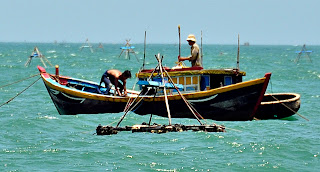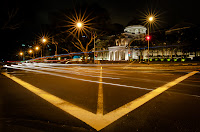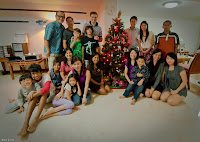I've started (more serious) photography for about a year now, reading up books, magazines, forum postings, and various photography blogs. With just a year under my belt, these is what I've learnt
1.Equipment.
At the beginning, it's about the equipment: Nikon or Canon (or even others... gasp?!) ; which lenses, zoom or prime, aperture sizes, etc.Now: it's really how you use the equipment. Upgrade when you have maximized and outgrown its use.
a. Camera body: Nikon D90
Read the manual. It's not a TV, or even an iPhone. You gotta read the manual, know which buttons do what, how to fully utilize all the functions hidden in the menus. The more you are familiar with the body, the easier it gets, and the more control you have over what you want to shoot. Then read the manual again.Limitations: I do now find the <100% view finder coverage, the 9 AF points a little bit of a (very minor) constraint. Yes, the D7000 is better, but as a beginner, it is hard to appreciate all the features the more advance/better D7000 can deliver.
But the dictum is true: spend more on lenses than body. No regrets starting with D90, learn the basics, master it, then move on.
And yes, I'm salivating at when D800 will come out. Too soon to upgrade to full frame? :)
b. Lenses
Armed with now 4 different lenses, here's what I think of em
 Nikon 18-200mm.
Nikon 18-200mm. Good: great all rounder, great for traveling, or shooting outdoors, in various diff scenarios, then you don't have to change lenses. This helped me better understand how shooting at various lengths affect the ultimately picture.
Bad: It does much more poorly in low light, due to the aperture size limitation. Pictures shot at 200mm, tend to be a bit soft (not as sharp) - like the one on the right.
I don't use it on a day-to-day now, only when I travel.
Nikon 35mm f1.8.
Good: cheap. light. small. Good for street photography as it is inconspicuous. (Right)Big aperture so good for low light. Also for taking things with shallow depth of field - which I use alot when I take food photos (see below).
Bad: just 1 focal length (yes, zoom with your feet), and sometimes you just need to go wider for group shots, which is not always possible indoors.
This lens is the default lens on my D90 now.
Nikon 24-70mm f2.8.
Good: Reputedly one of Nikon's best and widely used lenses. Good for portraits (see below).Also useful range to shoot, if you don't want to be all that close (like I shot for my son's 14th birthday).
Bad: Expensive, big and bulky FX lens (range isn't as versatile as a say 17-55 would be for DX). My most expensive but least used lens. I bought this, as I found a good reasonably priced 2nd hand piece in Vietnam.
But I wanted to try a professional grade lens. And I did. In hindsight, I would have gone for a Tamron or Sigma 17-50/55 f2.8 instead. Save the 24-70 for when I go full frame.
Tokina 11-16mm f2.8.
 Good: Ultra Wide Angle. Perfect for night landscape/cityscape shots. Not all that bulky. See right for sample shot.
Good: Ultra Wide Angle. Perfect for night landscape/cityscape shots. Not all that bulky. See right for sample shot. Bad: For portraits, or even group shots. See left - the edges get elongated. I should have used my 18-200 instead. Unless of course, you don't have space to move further back, then no choice but to use this.
Bad: For portraits, or even group shots. See left - the edges get elongated. I should have used my 18-200 instead. Unless of course, you don't have space to move further back, then no choice but to use this.This lens is also almost always with me.
If I had to start over again, I'll probably pick a Sigma 17-50 f2.8 lens instead of 18-200 (although it is hard for a beginner to be convinced of sacrificing zoom for aperture). Good range for DX, and big apertures are really the way to go.
c.Other equipment
Tripod $300-500. One of those things, that you only appreciate if you have it, and use it. The thought of lugging a tripod around, is daunting. But it is probably the next most important thing to have, after body and lens. You need the tripod to take night city shots, with nice light trails, star burst lights - buildings that come alive! Also, taking group shots, it is hard to ask just anyone to use your DSLR and snap away. You are better off setting it up, use a remote trigger to shoot.Oh, get a carbon fibre one - it's much lighter (esp when you have to lug it around). Sirui makes reasonably priced ones. I have not outgrown it yet, so can't think to justify getting a Manfrotto or Gitzo.
Remote trigger $15 for original.
Small, cheap, prevents camera shake, a buddy for tripod use. No brainer.
Lens Pens $12
Forget the cheap imitation ones (I tried those). Get the original, it works wonders in cleaning lenses. Not that expensive anyway. Get a few.
Spares
Keep a spare battery; and spare memory card with you.
Not a lot of money, but will save your neck (forgot to charge battery, left memory card somewhere).
2. Understanding basics
It's fun to research about equipment, and go buy them. But the quality of the photos, is more about how you use what you have, then what you have.... really!a.Start by understanding the basics
Aperture; Shutter Speed; ISO. Don't be afraid to use Manual mode - it isn't as scary as it seems. Bryan Peterson's Understanding Exposure is a great book to start off with. Highly recommended. Gives you confidence to shoot in manual. I also found Scott Kelby's trio of starter books an easy start, not too technical.
b.Understand how your camera works
Know how to switch from auto-focus to manual focus, or single point focus. Know how to change the settings quickly.
c.Understand the uses and limitation of the various lenses
There is no 1 best lens. There always is a compromise, for each lens. So be familiar with each of your lenses, know which is good for what circumstances - so that you don't have to drag all your lenses out with you (they are heavy!). Then go shoot lots, experiment with the settings, trial and error. It's how you learn, build and gain confidence.
3.Workflow and Raw
I hated shooting in Raw, because the in camera Jpeg always turned out better processed. That is until I got hold of Adobe's Lightroom. This is a highly highly recommended software to get.Firstly, it auto imports all your pictures, files them (how you want them to file), allows you to add key words, flag them, put star ratings on them - a fabulous database management to help you sort through and find thousands of pictures easily. Getting it all set up, is a pain. But short term pain, has long term gains.
Anyway, after searching and researching, this is my workflow.
a.Put SD card in computer
b.LR detects and imports. I add in auto-tuning and basic keywords to the whole batch.
c.I sort all my pictures in Countries/Cities, then get LR to file the pictures in dates via sub-folders. Doesn't matter how you decide, just be consistent.
d.I go through the pictures quickly, cull them down to typically half or even less.
e.I go through them again, flag those I want to process
f.Then I "develop" those flagged pictures, changing temp, tones, light, change to B&W etc. Note that LR's changes are non-destructive, so any changes can be undone. Presets available make developing easy! and you also have the option to finetune it bit by bit, if you want.
g.I also add in more specific keywords/ratings to the final selected pictures.
h.Finally, I export them as Jpeg into a temp folder - to publish to Facebook or other websites. Also easy to sync folder to iPad/iTouch/iPhone.
Sometimes I add simple watermark, size changes depends on what I want to use them for. The good thing is, you can export numerous times, easily.
Ok, with the above, shooting in RAW works the best.
No added steps, seamless, and with RAW, you retain all the info captured, so you really don't have to bother with white balance anymore, and keep the picture at the highest quality. Sure it takes up more space, but SD cards and hard disk space isn't all that expensive nowadays. A 16 GB SD card (costing $30) can take more than 1000 raw files. That's plenty. I keep an extra card with me, just in case.
4. Learn, and keep learning
In today's world, access to information has never been easier (or more complicated!). I researched a lot of the above info, from the internet, forum postings, photog websites, magazines, youtube etc.
Favorite Magazine: Digital Camera (S$6.50 per month).
Favorite Website: Digital Photography School
Favorite books: Digital Photography by Scott Kelby; Understanding Exposure by Bryan Petterson. Both excellent books for the beginner.
5.Join others
Also, I've joined a facebook group of Indonesian Photographers (Motoyuk), where we submit pictures with all the technical advise, and get critiqued! Very humbling first time, but you'll learn how others see things, people with more experience give advise how to improve the shot. Also you'll see what kind of shots others shoot, with different technique and settings.
It's worth linking up with fellow like-minded enthusiasts, whether through Facebook, and a real life club. And great fun too!
6.Where to post/host your pictures?
I'm a regular facebook poster. Ok, that may be an understatement....Besides facebook (which is more social), I did think about where I can put my pictures,in a more serious way?
http://www.flickr.com.
Too large a community, your photos get lost. I use it only to host pictures, where I want to post pictures in forums.
http://www.smugmug.com
I thought about doing a facebook page, or setting up my own photography website.
I wanted a place to showcase my "work". I didn't find Flickr's format to be all that inspiring. Tried out Wix; Smugmug and others. In the end, I found Smugmug to be the easiest to use, and nicest.
Well, after the trial period, I didn't sign up for Smugmug. I am not earning any money from photography, don't have any clients, no one to showcase my work too.
Honestly, for my own purpose, uploaded to Facebook is good enough for me.
http://500px.com
This is a place, for more serious photographers. You can upload your pictures, and other photographers can rate them. It's also a great place to see fantastic pictures!
When I first uploaded (10 at a go), I got views, some ratings and comments.
Unfortunately, the later pictures, had zero views. Maybe better to upload in batches.
7.Post online/Enter competitions
Something I only recently tried, is to see where you stand. I've started submitting a few photos for either online curated galleries, or competitions - just for the hack of it! You don't lose anything, but I will raise the bar/standards.
http://www.fineart-portugal.com
A curated gallery. Very high standards, only top 24 each day are published. I've never made it....
You can only upload like 1 picture 6 days?
http://www.podiumfoto.com
The lesser cousin. Also curated - but no quota, and standards are lower. I've submitted 7, and all 7 have been published. Bit of a morale booster :)
You can only upload like 1 picture in every 4 days?
http://www.pixoto.com/images-photography
My current favorite website, and highly addictive.
No limit to uploading pictures, ALL your photos get "competed" against others of the same category, and you'll be scored and ranked. Almost instant feedback for how good a picture is, rated by fellow photographers.
Besides the competing part, the pictures are inspiring, gives you ideas on things to shoot.
https://www.facebook.com/groups/gpindo/
There are also facebook groups, where you can post pictures. I've been posting a few times, get some comments or "likes" - which is an ego inflating thing :).
Strangely, 1 pictures which was posted, which slipped unnoticed (no comments or likes), instead ended up as this....
http://www.gphotoindo.com/?p=22782
8.Setting goals
Well, that's my 1st year.For 2012, I'm thinking of setting some photography goals.
a.I want to learn how to shoot the "Brenizer" method, like this shot.
http://www.ryanbrenizer.com/2011/12/panorama-on-the-sly/
b.Flash
I'm flirting in getting a flash, or reading up more on flash.
I don't really know how to use one properly, and have no intention (for now) to do fashion shoots, or cumbersome complicated shoots with multiple flashes.
I think it would be a useful skill to shoot indoors, with a flash, without it being obvious a flash was used.
c.Full frame?
Big sensor, high ISO sounds very tempting. The day I can tell a FX picture from a DX picture, is the day I'll get the D800. Yes, it's a slippery slope.... haha.
ok, that's it from me for now. If you have questions (assuming there are readers... haha), ask!
Happy shooting :)
Soo Sing



I have the 18-200 lens on my D7000. it definitely has some limitations. I am going to start researching a new lens, and taking some classes. I have this great camera and I am consistently disappointed in how my pictures come out. Sigh.
ReplyDeleteGreat post though. Maybe I will start looking at some of the websites you suggested!
Erin
Shoot more with your 50mm - it's one of the sharpest lenses around.
ReplyDeleteDid u get the bryan Peterson book? It's a good book to teach u the fundamentals - then go practice and shoot!
A class will also help - depending on time available.
Feel free to post/send me one of those pictures u aren't happy with, with the Exif data. I will be happy to give a "critique" :)